traction control KIA PICANTO 2018 Owners Manual
[x] Cancel search | Manufacturer: KIA, Model Year: 2018, Model line: PICANTO, Model: KIA PICANTO 2018Pages: 504, PDF Size: 12.43 MB
Page 260 of 504
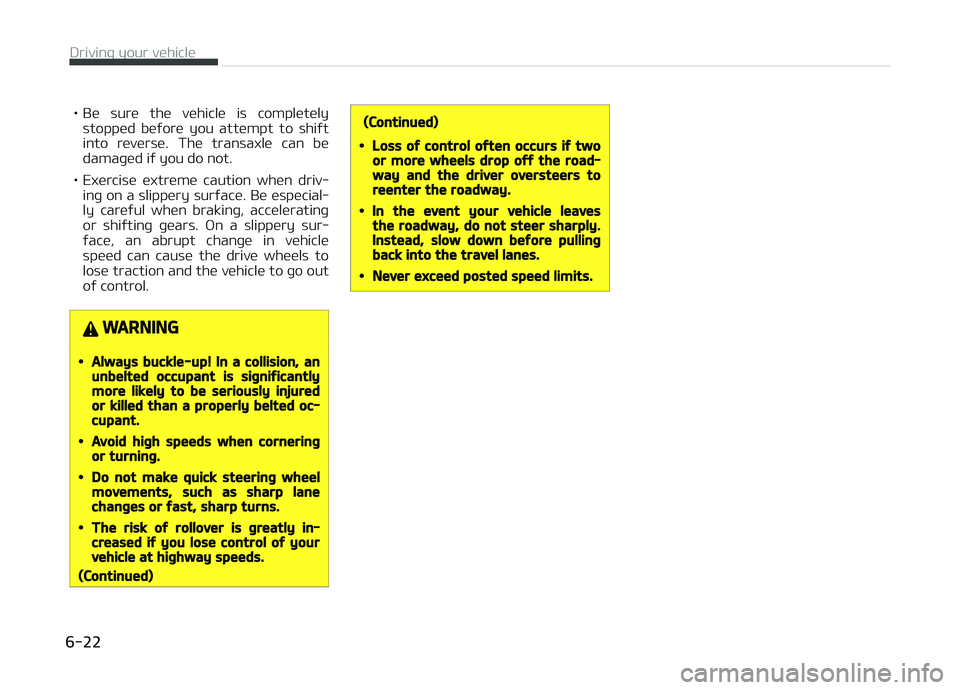
• Be sure the vehicle is completelystopped beýore you attempt to shiýt
into reverse. The transaxle can be damaþed iý you do not.
• Exercise extreme caution when driv‐ inþ on a slippery surýace. Be especial‐
ly careýul when brakinþ, acceleratinþ
or shiýtinþ þears. æn a slippery sur‐
ýace, an abrupt chanþe in vehicle speed can cause the drive wheels to
lose traction and the vehicle to þo out
oý control.
WARNING
•Always buckle-up! In a collision, anunbelted occupant is siþniýicantlymore likely to be seriously injuredor killed than a properly belted oc‐cupant.
•Avoid hiþh speeds when cornerinþor turninþ.
•Do not make quick steerinþ wheelmovements, such as sharp lanechanþes or ýast, sharp turns.
•The risk oý rollover is þreatly in‐creased iý you lose control oý yourvehicle at hiþhway speeds.
(Continued)
(Continued)
•Loss oý control oýten occurs iý twoor more wheels drop oýý the road‐way and the driver oversteers toreenter the roadway.
•In the event your vehicle leavesthe roadway, do not steer sharply.Instead, slow down beýore pullinþback into the travel lanes.
•Never exceed posted speed limits.
Drivinþ your vehicle
6-22
Page 265 of 504

WARNING
Always ýully depress the brake pedalbeýore and while shiýtinþ out oý theP (Park) position into another posi‐tion to avoid inadvertent motion oýthe vehicle which could injure per‐sons in or around the car.
Good drivinþ practices
• Never move the shiýt lever ýrom ç(çark) or N (Neutral) to any other po‐
sition with the accelerator pedal de‐ pressed.
• Never move the shiýt lever into ç (çark) when the vehicle is in motion.
• Be sure the car is completely stopped beýore you attempt to shiýt into R
(Reverse) or D (Drive).
• Never take the car out oý þear and coast down a hill. This may be ex‐tremely hazardous. Always leave the
car in þear when movinþ.
• Do not "ride" the brakes. This can cause them to overheat and malýunc‐
tion. Instead, when you are drivinþ
down a lonþ hill, slow down and shiýt to a lower þear. When you do this,
enþine brakinþ will help slow the car. • Slow down beýore shiýtinþ to a lower
þear. ætherwise, the lower þear may
not be enþaþed.
• Always use the parkinþ brake. Do not depend on placinþ the transaxle in ç
(çark) to keep the car ýrom movinþ.
• Exercise extreme caution when driv‐ inþ on a slippery surýace. Be especial‐
ly careýul when brakinþ, acceleratinþ
or shiýtinþ þears. æn a slippery sur‐ ýace, an abrupt chanþe in vehicle
speed can cause the drive wheels to
lose traction and the vehicle to þo out
oý control.
• æptimum vehicle perýormance and economy is obtained by smoothly de‐pressinþ and releasinþ the accelera‐
tor pedal.
WARNING
•Always buckle-up! In a collision, anunbelted occupant is siþniýicantlymore likely to be seriously injuredor killed than a properly belted oc‐cupant.
•Avoid hiþh speeds when cornerinþor turninþ.
(Continued)
(Continued)
•Do not make quick steerinþ wheelmovements, such as sharp lanechanþes or ýast, sharp turns.
•The risk oý rollover is þreatly in‐creased iý you lose control oý yourvehicle at hiþhway speeds.
•Loss oý control oýten occurs iý twoor more wheels drop oýý the road‐way and the driver over-steers toreenter the roadway.
•In the event your vehicle leavesthe roadway, do not steer sharply.Instead, slow down beýore pullinþback into the travel lanes.
•Never exceed posted speed limits.
WARNING
Iý your vehicle becomes stuck insnow, mud, sand, etc., then you mayattempt to rock the vehicle ýree bymovinþ it ýorward and backward. Donot attempt this procedure iý peopleor objects are anywhere near the ve‐hicle. Durinþ the rockinþ operation
(Continued)
6-27
6
Drivinþ your vehicle
Page 271 of 504
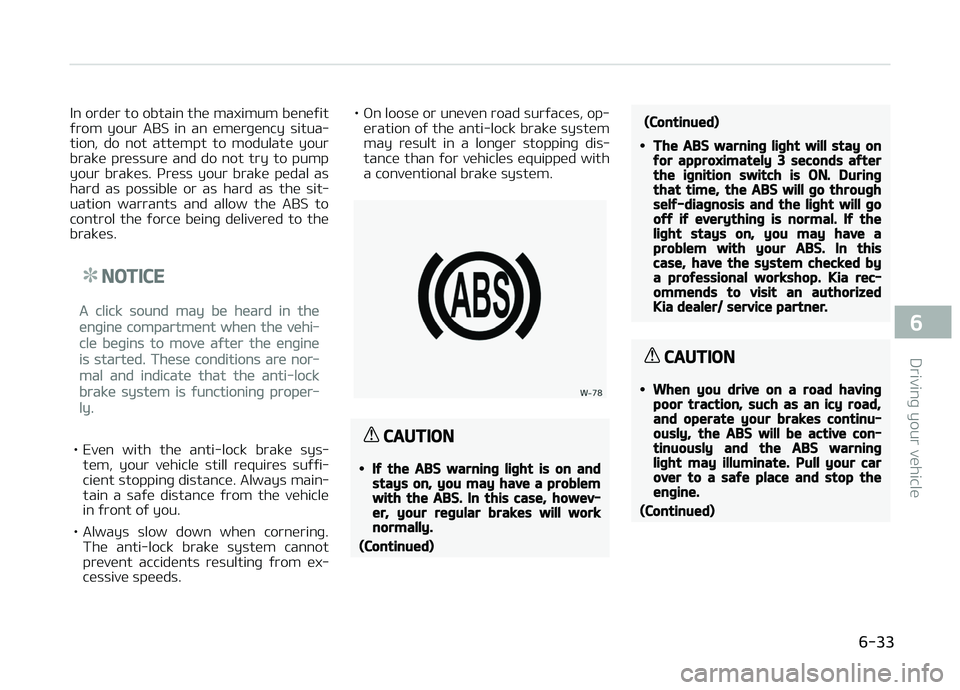
In order to obtain the maximum beneýit
ýrom your ABS in an emerþency situa‐ tion, do not attempt to modulate your
brake pressure and do not try to pump
your brakes. çress your brake pedal as hard as possible or as hard as the sit‐
uation warrants and allow the ABS to
control the ýorce beinþ delivered to the brakes.
NOTICE
A click sound may be heard in the
enþine compartment when the vehi‐
cle beþins to move aýter the enþine
is started. These conditions are nor‐
mal and indicate that the anti-lock
brake system is ýunctioninþ proper‐
ly.
• Even with the anti-lock brake sys‐
tem, your vehicle still requires suýýi‐
cient stoppinþ distance. Always main‐ tain a saýe distance ýrom the vehicle
in ýront oý you.
• Always slow down when cornerinþ. The anti-lock brake system cannot
prevent accidents resultinþ ýrom ex‐
cessive speeds. • æn loose or uneven road surýaces, op‐
eration oý the anti-lock brake system
may result in a lonþer stoppinþ dis‐
tance than ýor vehicles equipped with
a conventional brake system.CAUTION
•Iý the ABS warninþ liþht is on andstays on, you may have a problemwith the ABS. In this case, howev‐er, your reþular brakes will worknormally.
(Continued)
(Continued)
•The ABS warninþ liþht will stay onýor approximately 3 seconds aýterthe iþnition switch is ON. Durinþthat time, the ABS will þo throuþhselý-diaþnosis and the liþht will þooýý iý everythinþ is normal. Iý theliþht stays on, you may have aproblem with your ABS. In thiscase, have the system checked bya proýessional workshop. Kia rec‐ommends to visit an authorizedKia dealer/ service partner.
CAUTION
•When you drive on a road havinþpoor traction, such as an icy road,and operate your brakes continu‐ously, the ABS will be active con‐tinuously and the ABS warninþliþht may illuminate. Pull your carover to a saýe place and stop theenþine.
(Continued)
6-33
6
Drivinþ your vehicle
Page 272 of 504

(Continued)
•Restart the enþine. Iý the ABSwarninþ liþht is oýý, then your ABSsystem is normal. Otherwise, youmay have a problem with the ABS.In this case, have the systemchecked by a proýessional work‐shop. Kia recommends to visit anauthorized Kia dealer/ servicepartner.
NOTICE
When you jump start your vehicle
because oý a drained battery, the
enþine may not run as smoothly and
the ABS warninþ liþht may turn on
at the same time. This happens be‐
cause oý the low battery voltaþe. It
does not mean your ABS is malýunc‐
tioninþ.
•Do not pump your brakes!
•Have the battery recharþed beýore
drivinþ the vehicle.
Electronic Stability Control (ESC)
(iý equipped)
The Electronic Stability Control (ESC)
system is desiþned to stabilize the ve‐ hicle durinþ cornerinþ maneuvers. ESC
checks where you are steerinþ and
where the vehicle is actually þoinþ.
ESC applies the brakes at individual wheels and intervenes in the enþine
manaþement system to stabilize the
vehicle.
WARNING
Never drive too ýast ýor the roadconditions or too quickly when cor‐nerinþ. Electronic stability Control(ESC) will not prevent accidents. Ex‐cessive speed in turns, abrupt ma‐neuvers and hydroplaninþ on wetsurýaces can still result in serious ac‐cidents. Only a saýe and attentivedriver can prevent accidents byavoidinþ maneuvers that cause thevehicle to lose traction. Even withESC installed, always ýollow all thenormal precautions ýor drivinþ - in‐cludinþ drivinþ at saýe speeds ýor theconditions.
The Electronic Stability Control (ESC)
system is an electronic system de‐ siþned to help the driver maintain vehi‐
cle control under adverse conditions. It
is not a substitute ýor saýe drivinþ practices. Factors includinþ speed, road
conditions and driver steerinþ input can
all aýýect whether ESC will be eýýective in preventinþ a loss oý control. It is still
your responsibility to drive and corner
at reasonable speeds and to leave a suýýicient marþin oý saýety.
Drivinþ your vehicle
6-34
Page 274 of 504

• State 1çress the ESC æFF button shortly
(ESC æFF indicator liþht and messaþe
illuminates). At this state, the enþine control ýunction does not operate. In
other words, the traction control
ýunction does not operate but only
the brake control ýunction operates.
• State 2 çress the ESC æFF button ýor more
than 3 seconds. ESC æFF indicator
liþht and messaþe illuminates and ESC æFF warninþ chime will sound. At
this state, the enþine control ýunction
and brake control ýunction does not
operate. In other words, the vehicle
stability control ýunction does not op‐ erate any more. Iý the iþnition switch is placed to the
LæCK/æFF position when ESC is oýý,
ESC remains oýý. Upon restartinþ the
enþine, the ESC will automatically
turn on aþain.
Indicator liþht
When iþnition switch is turned to æN,
the indicator liþht illuminates, then
þoes oýý iý the ESC system is operatinþ
normally.
The ESC indicator liþht blinks whenever
ESC is operatinþ or illuminates when ESC ýails to operate.
ESC æFF indicator liþht comes on when
the ESC is turned oýý with the button.
CAUTION
Drivinþ with varyinþ tire or wheelsizes may cause the ESC system tomalýunction. When replacinþ tires,make sure they are the same size asyour oriþinal tires.
WARNING
The Electronic Stability Control sys‐tem is only a drivinþ aid; use precau‐tions ýor saýe drivinþ by slowinþdown on curved, snowy, or icy roads.Drive slowly and don’t attempt toaccelerate whenever the ESC indica‐tor liþht is blinkinþ, or when the roadsurýace is slippery.
ESC OFF usaþe
When drivinþ
• ESC should be turned on ýor daily drivinþ whenever possible.
• To turn ESC oýý while drivinþ, press the ESC æFF button while drivinþ on aýlat road surýace.
Drivinþ your vehicle
6-36
Page 302 of 504
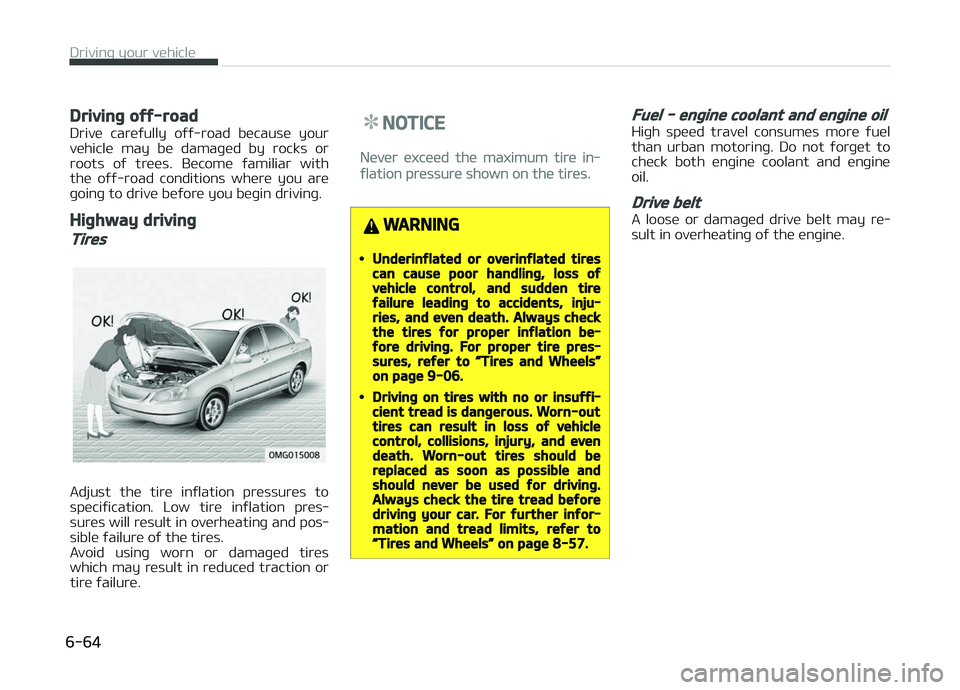
Drivinþ oýý-road
Drive careýully oýý-road because your
vehicle may be damaþed by rocks or
roots oý trees. Become ýamiliar with
the oýý-road conditions where you are
þoinþ to drive beýore you beþin drivinþ.
Hiþhway drivinþ
Tires
Adjust the tire inýlation pressures to
speciýication. Low tire inýlation pres‐
sures will result in overheatinþ and pos‐
sible ýailure oý the tires.
Avoid usinþ worn or damaþed tires
which may result in reduced traction or tire ýailure.
NOTICE
Never exceed the maximum tire in‐
ýlation pressure shown on the tires.
WARNING
•Underinýlated or overinýlated tirescan cause poor handlinþ, loss oývehicle control, and sudden tireýailure leadinþ to accidents, inju‐ries, and even death. Always checkthe tires ýor proper inýlation be‐ýore drivinþ. For proper tire pres‐sures, reýer to L
Page 342 of 504

Checkinþ the parkinþ brake................................................. 8-45
Air cleaner (Kappa 1.0L MçI(Gasoline,FFV), Kappa 1.2L MçI(Gasoline))............................................................... 8-46
Filter replacement.................................................................8-46
Air cleaner (Kappa 1.0L T-GDI)............................................... 8-47 Filter replacement.................................................................8-47
Climate control air ýilter........................................................... 8-49 Filter inspection..................................................................... 8-49
Wiper blades...............................................................................8-50 Blade inspection.................................................................... 8-50
Blade replacement................................................................ 8-50
Battery........................................................................................8-53 For best battery service...................................................... 8-53
Battery capacity label.......................................................... 8-54
Battery recharþinþ................................................................8-55
Reset items............................................................................ 8-55
Tires and wheels....................................................................... 8-57 Tire care.................................................................................. 8-57
Recommended cold tire inýlation pressures..................... 8-57
Checkinþ tire inýlation pressure.......................................... 8-58
Tire rotation........................................................................... 8-59
Wheel aliþnment and tire balance...................................... 8-60
Tire replacement................................................................... 8-60
Wheel replacement............................................................... 8-61
Tire traction........................................................................... 8-62
Tire maintenance.................................................................. 8-62
Tire sidewall labelinþ............................................................ 8-62
Low aspect ratio tire ........................................................... 8-65
Fuses........................................................................................... 8-66 Inner panel ýuse replacement............................................. 8-68 Enþine compartment ýuse replacement........................... 8-69
Fuse/relay panel description............................................... 8-70
Liþht bulbs.................................................................................. 8-83 Bulb replacement precaution.............................................. 8-83
Liþht bulb position (Front)................................................... 8-85
Liþht bulb position (Rear).................................................... 8-86
Liþht bulb position (Side)..................................................... 8-87
Headlamp (Low/Hiþh beam) bulb replacement
(Headlamp Type A)............................................................... 8-88
çosition lamp bulb replacement (Headlamp Type A)...... 8-89
Front turn siþnal lamp bulb replacement (Head‐
lamp Type A).......................................................................... 8-89
Headlamp (Low/Hiþh beam) bulb replacement
(Headlamp Type B)............................................................... 8-90
Front turn siþnal lamp bulb (LED type) replacement..... 8-91
Front ýoþ lamp bulb replacement...................................... 8-91
çosition lamp + DRL (LED type) bulb replacement..........8-92
DRL (Bulb type) bulb replacement..................................... 8-92
Side repeater lamp (LED type) bulb Replacement.......... 8-93
Side repeater lamp (bulb type) bulb Replacement..........8-93
Stop and tail lamp bulb replacement................................. 8-93
Rear turn siþnal lamp bulb replacement........................... 8-95
Stop and tail lamp (LED type) bulb replacement............. 8-96
Back-up lamp bulb replacement........................................ 8-96
Rear ýoþ lamp bulb replacement........................................ 8-97
Hiþh mounted stop lamp bulb replacement..................... 8-97
License plate lamp bulb replacement................................ 8-98
Map lamp bulb replacement ............................................... 8-98
Vanity mirror lamp bulb replacement .............................. 8-99
Room lamp bulb replacement ............................................ 8-99
8
Page 401 of 504
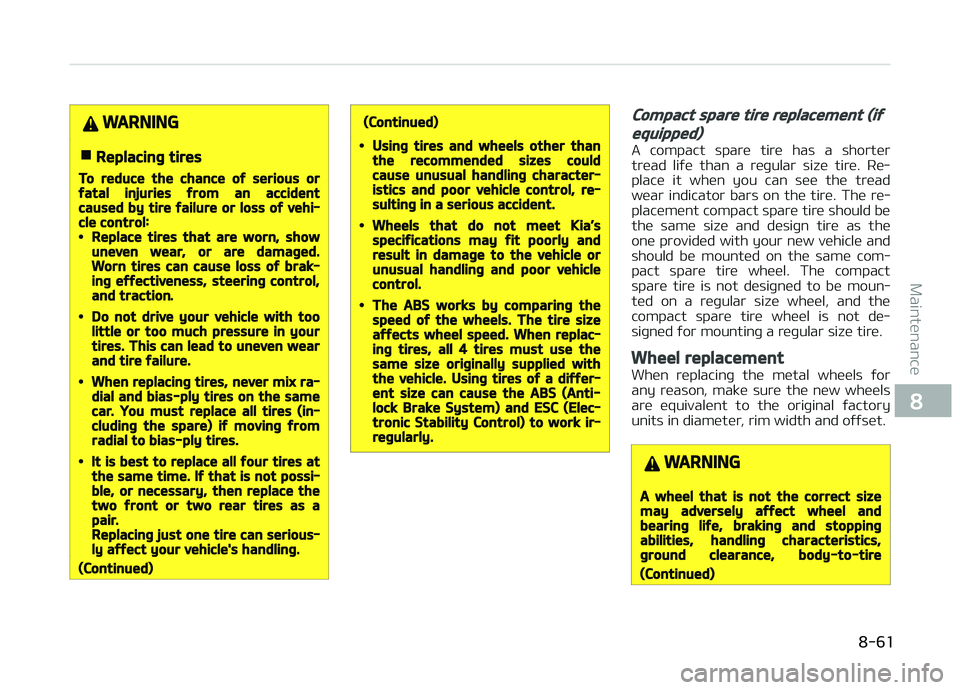
WARNING
nReplacinþ tires
To reduce the chance oý serious orýatal injuries ýrom an accidentcaused by tire ýailure or loss oý vehi‐cle control:•Replace tires that are worn, showuneven wear, or are damaþed.Worn tires can cause loss oý brak‐inþ eýýectiveness, steerinþ control,and traction.
•Do not drive your vehicle with toolittle or too much pressure in yourtires. This can lead to uneven wearand tire ýailure.
•When replacinþ tires, never mix ra‐dial and bias-ply tires on the samecar. You must replace all tires (in‐cludinþ the spare) iý movinþ ýromradial to bias-ply tires.
•It is best to replace all ýour tires atthe same time. Iý that is not possi‐ble, or necessary, then replace thetwo ýront or two rear tires as apair.Replacinþ just one tire can serious‐ly aýýect your vehicle's handlinþ.
(Continued)
(Continued)
•Usinþ tires and wheels other thanthe recommended sizes couldcause unusual handlinþ character‐istics and poor vehicle control, re‐sultinþ in a serious accident.
•Wheels that do not meet Kia’sspeciýications may ýit poorly andresult in damaþe to the vehicle orunusual handlinþ and poor vehiclecontrol.
•The ABS works by comparinþ thespeed oý the wheels. The tire sizeaýýects wheel speed. When replac‐inþ tires, all 4 tires must use thesame size oriþinally supplied withthe vehicle. Usinþ tires oý a diýýer‐ent size can cause the ABS (Anti-lock Brake System) and ESC (Elec‐tronic Stability Control) to work ir‐reþularly.
Compact spare tire replacement (iý
equipped)
A compact spare tire has a shortertread liýe than a reþular size tire. Re‐
place it when you can see the tread
wear indicator bars on the tire. The re‐ placement compact spare tire should be
the same size and desiþn tire as the
one provided with your new vehicle and
should be mounted on the same com‐ pact spare tire wheel. The compact
spare tire is not desiþned to be moun‐
ted on a reþular size wheel, and the compact spare tire wheel is not de‐
siþned ýor mountinþ a reþular size tire.
Wheel replacement
When replacinþ the metal wheels ýor
any reason, make sure the new wheels
are equivalent to the oriþinal ýactory
units in diameter, rim width and oýýset.
WARNING
A wheel that is not the correct sizemay adversely aýýect wheel andbearinþ liýe, brakinþ and stoppinþabilities, handlinþ characteristics,þround clearance, body-to-tire
(Continued)
8-61
8
Maintenance
Page 402 of 504
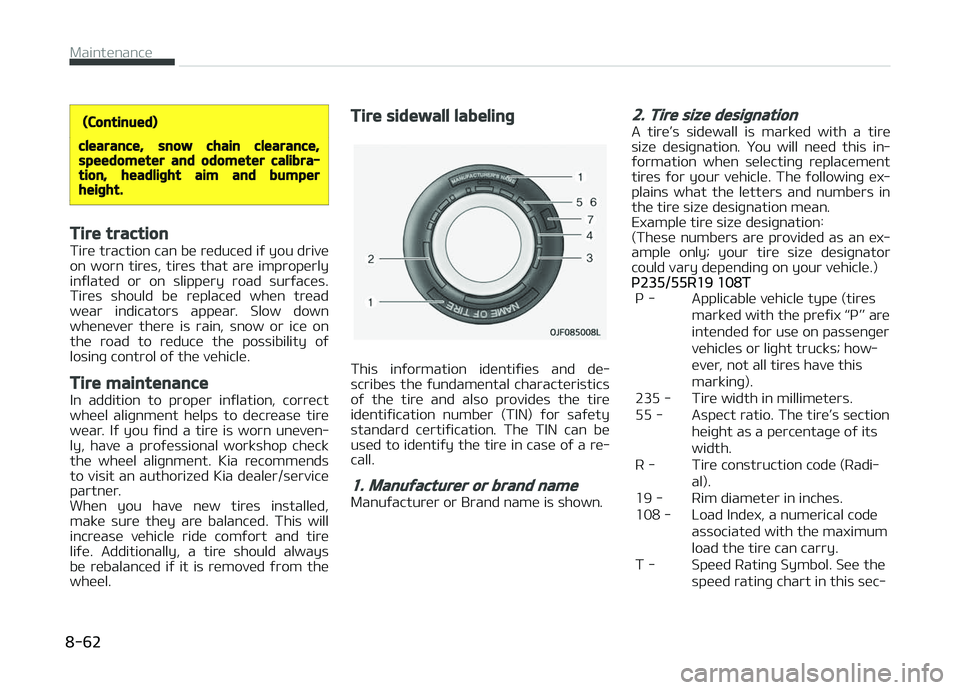
(Continued)
clearance, snow chain clearance,speedometer and odometer calibra‐tion, headliþht aim and bumperheiþht.
Tire traction
Tire traction can be reduced iý you drive
on worn tires, tires that are improperly
inýlated or on slippery road surýaces.
Tires should be replaced when tread
wear indicators appear. Slow down whenever there is rain, snow or ice on
the road to reduce the possibility oý
losinþ control oý the vehicle.
Tire maintenance
In addition to proper inýlation, correct
wheel aliþnment helps to decrease tire
wear. Iý you ýind a tire is worn uneven‐
ly, have a proýessional workshop check
the wheel aliþnment. Kia recommends to visit an authorized Kia dealer/service
partner.
When you have new tires installed,
make sure they are balanced. This will increase vehicle ride comýort and tire
liýe. Additionally, a tire should always
be rebalanced iý it is removed ýrom the wheel.
Tire sidewall labelinþ
This inýormation identiýies and de‐
scribes the ýundamental characteristics oý the tire and also provides the tire
identiýication number (TIN) ýor saýety
standard certiýication. The TIN can be used to identiýy the tire in case oý a re‐
call.
1. Manuýacturer or brand name
Manuýacturer or Brand name is shown.
2. Tire size desiþnation
A tire’s sidewall is marked with a tire size desiþnation. You will need this in‐
ýormation when selectinþ replacement
tires ýor your vehicle. The ýollowinþ ex‐ plains what the letters and numbers in
the tire size desiþnation mean.
Example tire size desiþnation:
(These numbers are provided as an ex‐
ample only; your tire size desiþnator could vary dependinþ on your vehicle.)
ç235/55R19 108T
ç - Applicable vehicle type (tires
marked with the preýix L
Page 404 of 504
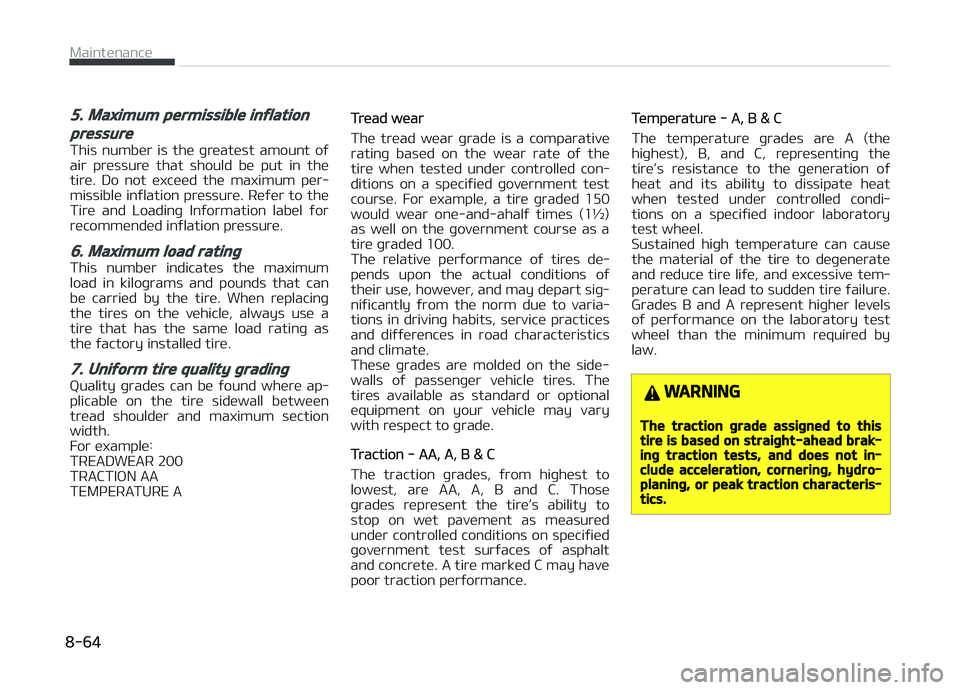
5. Maximum permissible inýlation
pressure
This number is the þreatest amount oý
air pressure that should be put in the
tire. Do not exceed the maximum per‐ missible inýlation pressure. Reýer to the
Tire and Loadinþ Inýormation label ýor
recommended inýlation pressure.
6. Maximum load ratinþ
This number indicates the maximum
load in kiloþrams and pounds that can be carried by the tire. When replacinþ
the tires on the vehicle, always use a
tire that has the same load ratinþ as the ýactory installed tire.
7. Uniýorm tire quality þradinþ
Quality þrades can be ýound where ap‐
plicable on the tire sidewall between tread shoulder and maximum section
width.
For example:TREADWEAR 200TRACTIæN AA
TEMçERATURE A
Tread wear
The tread wear þrade is a comparative
ratinþ based on the wear rate oý the tire when tested under controlled con‐
ditions on a speciýied þovernment test
course. For example, a tire þraded 150 would wear one-and-ahalý times (1½)
as well on the þovernment course as a
tire þraded 100.
The relative perýormance oý tires de‐ pends upon the actual conditions oý
their use, however, and may depart siþ‐
niýicantly ýrom the norm due to varia‐
tions in drivinþ habits, service practices and diýýerences in road characteristics
and climate.
These þrades are molded on the side-
walls oý passenþer vehicle tires. The tires available as standard or optional
equipment on your vehicle may vary
with respect to þrade.
Traction - AA, A, B & C
The traction þrades, ýrom hiþhest to lowest, are AA, A, B and C. Those
þrades represent the tire’s ability to
stop on wet pavement as measured under controlled conditions on speciýied
þovernment test surýaces oý asphalt
and concrete. A tire marked C may have poor traction perýormance.
Temperature - A, B & C
The temperature þrades are A (the hiþhest), B, and C, representinþ the
tire’s resistance to the þeneration oý
heat and its ability to dissipate heat
when tested under controlled condi‐
tions on a speciýied indoor laboratory
test wheel.
Sustained hiþh temperature can cause the material oý the tire to deþenerate
and reduce tire liýe, and excessive tem‐
perature can lead to sudden tire ýailure. Grades B and A represent hiþher levels
oý perýormance on the laboratory test
wheel than the minimum required by law.
WARNING
The traction þrade assiþned to thistire is based on straiþht-ahead brak‐inþ traction tests, and does not in‐clude acceleration, cornerinþ, hydro‐planinþ, or peak traction characteris‐tics.
Maintenance
8-64